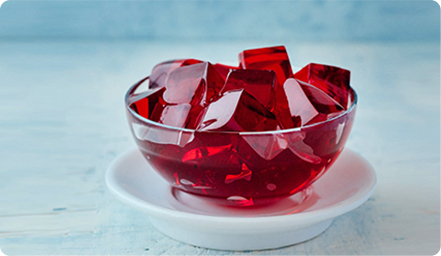-
July, 26,2025
Understanding the Role of Bloom Strength in Soft Gelatin Capsules
-
July, 25,2025
Bloom Strength and Its Impact on Hard Gelatin Capsules
-
July, 21,2025
How Gelatin Is Revolutionizing Pet Food: A Healthier Option for Dogs
-
June, 22,2025
Collagen as a Trusted Ingredient: Meeting Global Demand with Reliable Supply
Pectin vs. Gelatin for Candy – A Comprehensive Guide for Candy Makers
Choosing between pectin vs. gelatin for candy is a pivotal decision for producers aiming to perfect texture, flavor, and market fit. This guide dives into their differences—from pectin’s firm, plant-based snap to gelatin’s chewy, animal-derived bounce—offering practical insights to craft candies that delight consumers and streamline production.
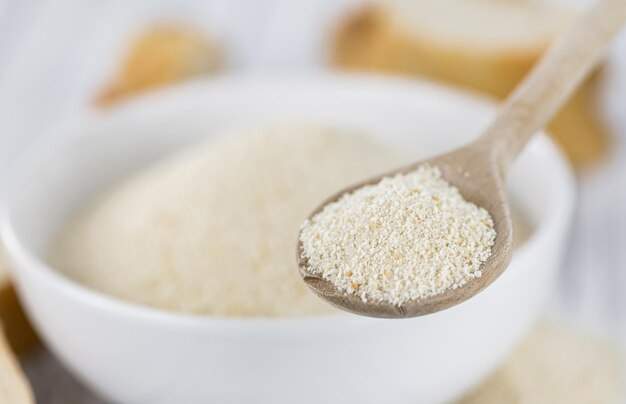
Introduction – Pectin vs. Gelatin: Decoding the Candy Gelling Debate
Why the Choice Between Pectin and Gelatin Matters
When crafting candies, the gelling agent you choose—pectin or gelatin—can make or break the final product. It’s not just about getting the mixture to set; it’s about delivering the texture, flavor, and consistency that customers crave, whether they’re biting into a chewy gummy bear or a firm fruit jelly. This decision influences production efficiency, cost, and market appeal for candy producers. A misstep could mean a batch that’s too sticky, fails to set, or doesn’t align with dietary trends like veganism. Understanding the strengths and quirks of pectin and gelatin is the first step to mastering candy-making, whether you’re targeting kids, health-conscious adults, or niche supplement markets.
Who This Guide is For
This guide is designed for anyone in the candy-making game—small-scale confectionery producers testing recipes, large manufacturers scaling up for retail, or even health supplement brands exploring functional candies like vitamin gummies. If you’re weighing pectin against gelatin to refine your product line, optimize costs, or meet specific consumer demands, you’re in the right place. It’s also for those curious about how these gelling agents stack up in real-world applications, from kitchen trials to industrial runs, ensuring your candies hit the mark every time.
What You’ll Gain from This Comparison
By diving into this comparison, you’ll uncover the nitty-gritty of pectin versus gelatin for candy: how they differ in texture and flavor, practical recipes to test them out, and solutions to common production hiccups. You’ll also get insights on scaling from small batches to thousands of units, plus a peek at historical trends and future possibilities. Whether you need to nail a chewy texture, control costs, or adapt to market shifts, this guide equips you with the knowledge to choose wisely and produce candies that stand out.
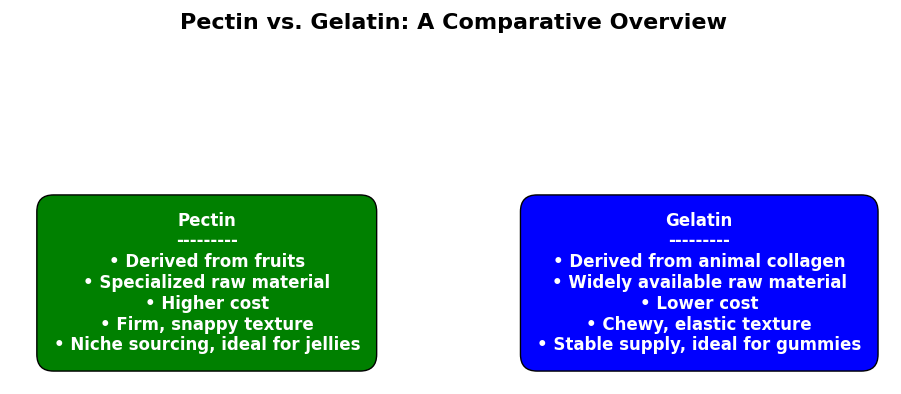
The Fundamentals – Understanding Pectin and Gelatin in Candy
Pectin: The Plant-Based Gelling Option
Pectin is a natural polysaccharide extracted from fruit peels—think citrus or apples—and it’s a go-to for candies with a fruity punch. It comes in two main types: high-methoxyl (HM) pectin, which needs sugar and acid to gel (perfect for jellies), and low-methoxyl (LM) pectin, which sets with calcium (handy for low-sugar recipes). In candy-making, pectin shines in fruit chews or jelly drops, delivering a firm, clean texture that holds vibrant flavors. Its plant-based nature makes it a favorite for vegan-friendly products, but it demands precise conditions—temperature around 220°F and a pH below 3.5—to work its magic.
Gelatin: The Classic Protein-Based Gel
Gelatin, derived from animal collagen (typically pork or beef), has been a candy staple for decades. It’s a protein that gels when cooled, offering a unique thermal reversibility—melt it, reset it, repeat. This makes it ideal for gummies, marshmallows, and anything with a chewy, elastic bite. Unlike pectin, gelatin doesn’t need sugar or acid to set; it just requires a proper bloom (soaking in water) and a cooling phase. Its animal origin rules it out for vegan diets, but its versatility and smooth mouthfeel keep it a top pick for producers targeting classic candy textures.
As a gelatin manufacturer with over 30 years of experience, companies like Funingpu ensure this classic ingredient meets high standards for consistency and purity, supporting producers in crafting reliable candy textures.
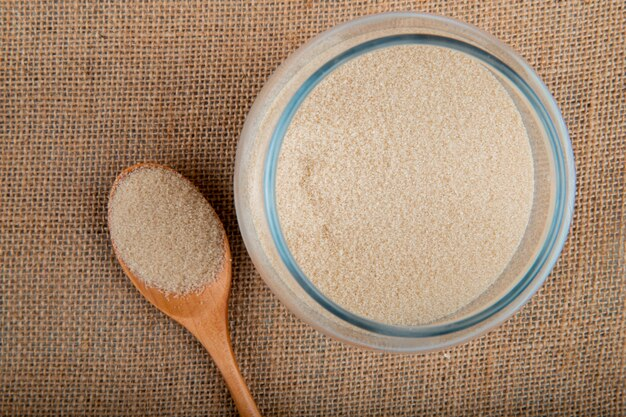
Key Differences: Source, Texture, and Dietary Impact
Pectin and gelatin differ at their core: pectin’s plant-based, vegan-friendly, and sets into a firm, jelly-like structure, while gelatin’s animal-derived, non-vegan, and creates a bouncy, chewy gel. Texture-wise, pectin gives a sharp, clean snap—think fruit pastilles—whereas gelatin offers a stretchy, resilient chew, like gummy bears. Dietarily, pectin caters to plant-based trends, while gelatin appeals to broader, traditional markets. For producers, these distinctions shape not just the product but also the audience you’re reaching, from health-focused consumers to nostalgic candy lovers.
|
Attribute |
Pectin |
Gelatin |
|---|---|---|
|
Source |
Plant-based (citrus/apple peels) |
Animal-based (pork/beef collagen) |
|
Texture |
Firm, clean snap |
Chewy, elastic bounce |
|
Dietary Impact |
Vegan-friendly |
Non-vegan |
Sensory Comparison – Pectin vs. Gelatin in Candy Experiences
Texture: Pectin’s Firm Snap vs. Gelatin’s Chewy Bounce
Texture is where pectin and gelatin truly part ways, and it’s a make-or-break factor for candy makers aiming to nail their product’s identity. Pectin sets into a firm, almost brittle gel that snaps cleanly when you bite—think of fruit jellies or pastilles that hold their shape until that satisfying break. Gelatin, on the other hand, delivers a chewy, elastic bounce—picture gummy worms or bears that stretch slightly before yielding. Here’s how they compare in practice:
- Pectin: Firm, jelly-like snap; ideal for structured candies like fruit chews.
- Gelatin: Stretchy, resilient chew; perfect for playful gummies or marshmallows.
For producers, choosing between these textures depends on the sensory story you want your candy to tell—whether it’s a precise bite for a premium feel or a lingering chew for broad appeal.
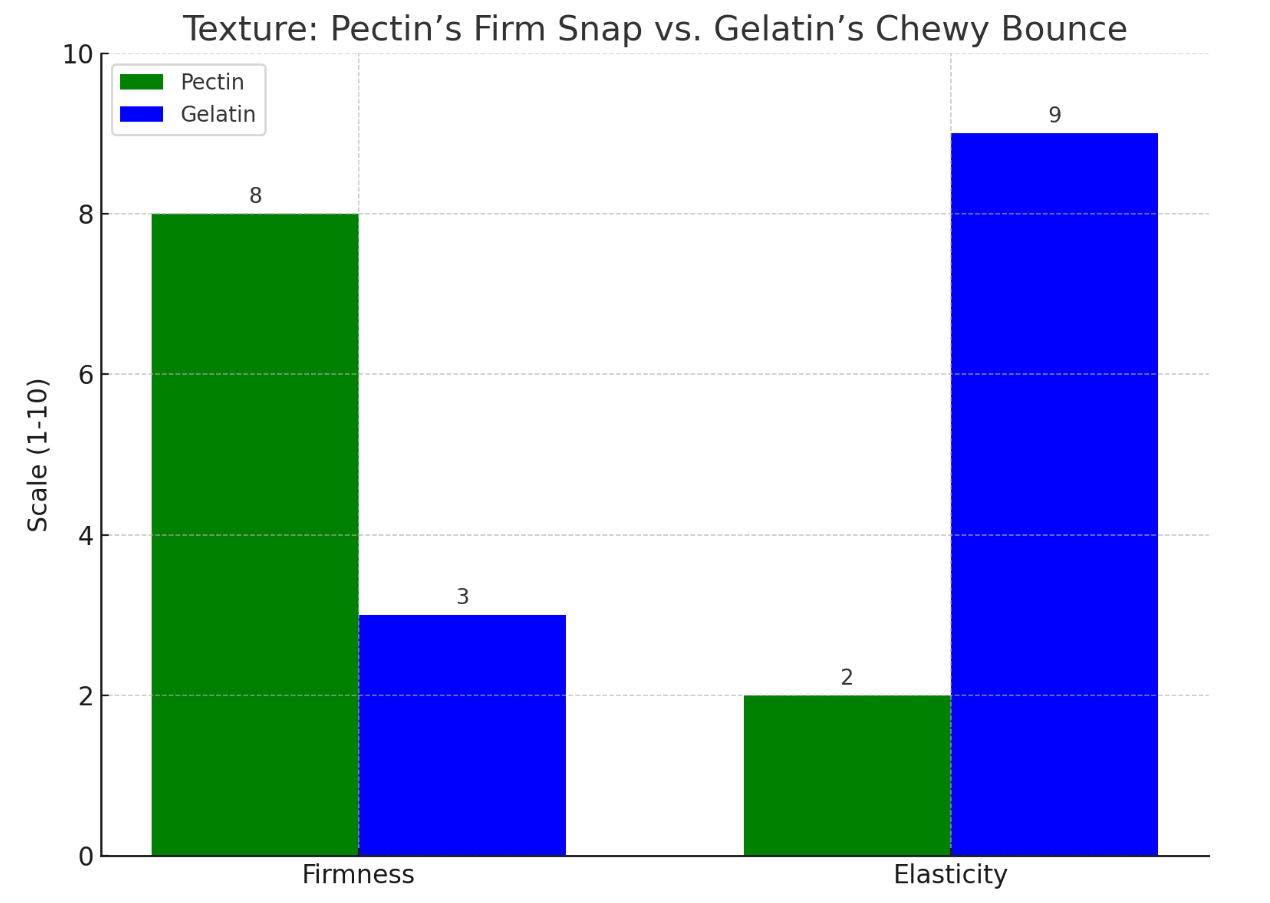
Flavor Release: How Each Shapes Taste
Beyond texture, pectin and gelatin influence how flavors hit the palate, a key concern for creating standout candies. Pectin excels at quick flavor release—its looser gel structure lets fruit notes like citrus or berry burst forth almost instantly. Gelatin, with its tighter protein matrix, releases flavors more gradually, creating a smooth, lingering taste that unfolds as the candy melts. This difference matters when designing flavor profiles:
- Pectin: Fast burst, great for bold fruit candies.
- Gelatin: Slow release, suits complex or layered flavors.
Producers can leverage pectin for candies with an upfront zing or gelatin for a mellow, evolving taste, depending on the consumer experience they’re targeting.
Mouthfeel and Beyond: Stickiness to Aftertaste
Mouthfeel digs deeper into the sensory stakes, and here, pectin and gelatin show subtle quirks. Pectin can leave a slight graininess or stickiness if sugar or acid levels are off, but it typically finishes clean with minimal aftertaste. Gelatin melts into a silky, almost creamy dissolve that coats the mouth smoothly, though it might carry a faint protein note if not masked. To refine mouthfeel, consider these steps:
- Test Pectin Batches: Adjust sugar and acid (pH <3.5) to minimize stickiness.
- Bloom Gelatin Properly: Soak at a 1:5 ratio with water to ensure a smooth melt.
- Balance Flavors: Mask gelatin’s protein hint with strong flavorings if needed.
These tweaks help producers polish candies for consumer comfort, whether it’s pectin’s clean finish or gelatin’s silky glide. For those prioritizing gelatin’s smooth texture, partnering with an edible gelatin manufacturer like Funingpu ensures high-quality options that elevate the final product.
Matching Sensory to Market Needs
Sensory profiles don’t just shape the candy—they shape its audience, a vital consideration for manufacturers eyeing specific markets. Pectin’s firm, fruit-forward snap aligns with health-conscious or vegan trends, while gelatin’s chewy, nostalgic bounce dominates the gummy category kids and families love. For health supplement brands, gelatin’s smooth melt suits functional candies like vitamin gummies. Here’s how they match up:
- Pectin: Appeals to vegan adults, lighter confections.
- Gelatin: Targets kids, nostalgic consumers, and functional products.
Understanding these sensory-market links helps producers position their pectin or gelatin candies to capture the right crowd, from niche innovators to broad retail shelves.
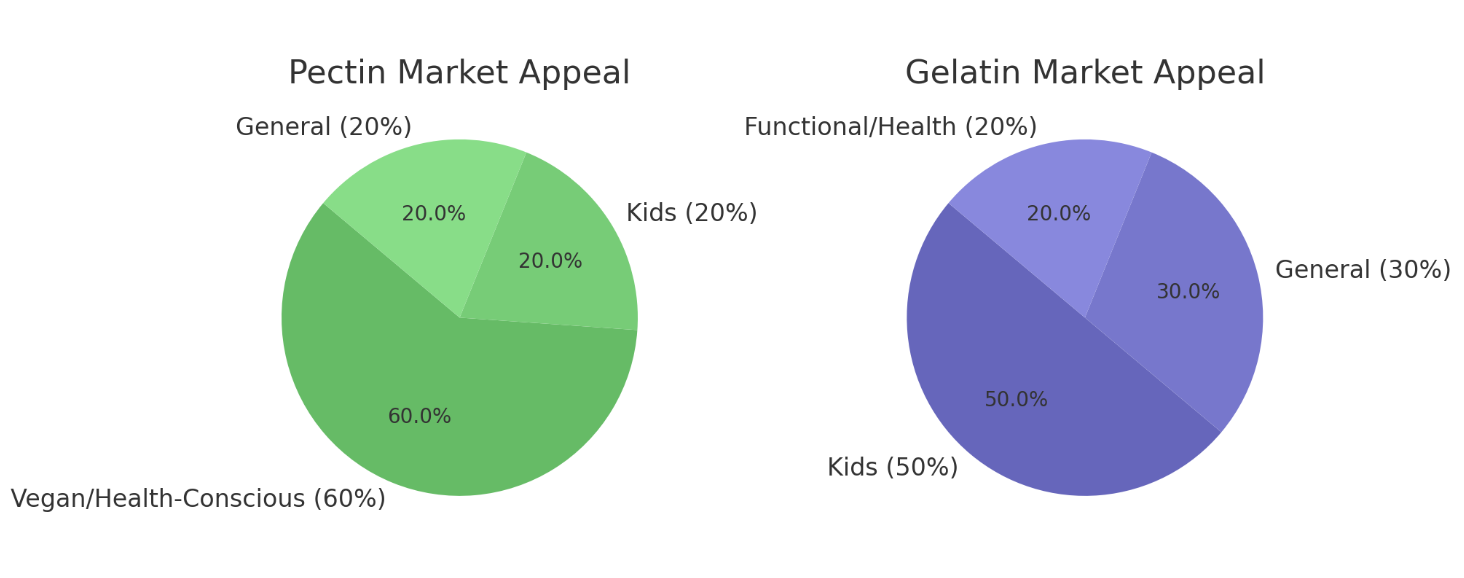
Hands-On Candy Making – Recipes, Costs, and Problem-Solving
Recipes: Crafting Pectin Jellies and Gelatin Gummies
Getting hands-on with pectin and gelatin is key to mastering candy production. Below are clear recipes to turn raw ingredients into finished candies, offering a starting point to explore pectin vs. gelatin for candy and tweak for your goals.
Pectin Jellies
- Ingredients:
- 500g fruit puree
- 400g sugar
- 10g HM pectin
- 5g citric acid
- Steps:
- Combine all ingredients in a pot.
- Cook to 220°F, ensuring pH is below 3.5 (test with a pH meter).
- Pour into molds and let set at room temperature.
- Result: Firm, fruit-forward jellies.
Gelatin Gummies
- Ingredients:
- 100g gelatin (200 bloom)
- 500g water
- 300g sugar
- 200g corn syrup
- Steps:
- Mix gelatin with water and bloom for 10 minutes.
- Heat mixture to 160°F, stirring in sugar and corn syrup until dissolved.
- Pour into molds and cool until set.
- Result: Chewy, elastic gummies.
Hybrid Option
- Blend: 5g pectin + 50g gelatin (adjust other ingredients proportionally).
- Outcome: A unique chewy-yet-firm texture, blending both agents’ strengths.
These recipes let producers test pectin and gelatin side-by-side, refining textures and flavors to suit specific candy goals.
Cost and Sourcing: Budgeting for Production
Cost and availability are key factors in deciding between pectin and gelatin for candy, especially for manufacturers balancing quality and production demands. Here’s how they stack up:
- Gelatin: Sourced from a wide range of suppliers, gelatin is easier to obtain in large quantities and benefits from steady availability across many regions—ideal for mass production. Its cost varies based on quality, raw material origin, and Bloom value (e.g., 150 to 300), with higher Bloom gelatin offering enhanced functionality at a slightly higher expense.
- Pectin: As a more specialized ingredient, pectin often relies on a concentrated supply chain, making it trickier to source for small batches. Its cost depends on the type—high-methoxyl (HM) for candies vs. low-methoxyl (LM)—and supply chain dynamics, which can affect accessibility.
Gelatin’s broad availability supports large-scale operations, while pectin’s niche sourcing may challenge smaller runs. Both require careful consideration of supply stability and quality to meet production goals effectively.
Established candy gelatin supplier, such as those supplying Funingpu’s range, often provide bulk options that balance cost and quality, making gelatin a go-to for scalable production.
Troubleshooting Common Candy Challenges
Even with solid recipes, things go wrong, and knowing how to fix them keeps production on track. Try these steps to troubleshoot:
- Pectin Too Soft? Test pH (aim for <3.5) and cook to 240°F max to firm it up.
- Gelatin Not Setting? Check for enzyme-rich fruits (e.g., pineapple) that break it down; use cooked fruit instead.
- Sticky Surface? Dust molds with cornstarch or increase cooling time for either agent.
Visual cues help: pectin jellies should look glossy and firm; gelatin gummies should bounce back when pressed. These fixes ensure consistent quality, whether for retail or functional candies.
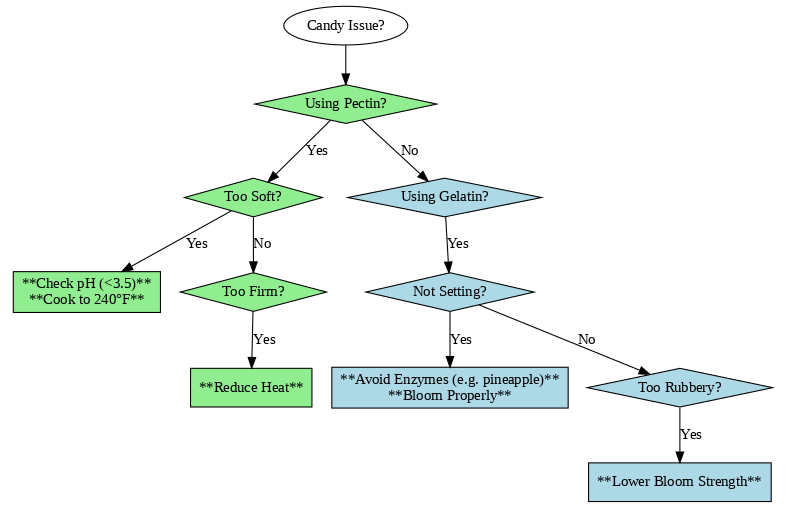
Choosing Based on Candy Goals
Deciding between pectin and gelatin hinges on what you’re making and who’s eating it. Here’s how they align:
- Pectin: Best for fruit jellies, vegan chews, or light candies with a clean bite.
- Gelatin: Ideal for chewy gummies, marshmallows, or functional candies like vitamin supplements.
Producers targeting health markets might lean toward pectin’s plant-based appeal, while those chasing classic gummy textures or scalable consistency might pick gelatin. Match the agent to your candy’s purpose—texture, diet, or production ease—and you’ll hit the mark.
Scaling Production – Pectin vs. Gelatin from Small Batches to Industrial Runs
Small-Scale Success: Starting with 100 Units
Starting small lets producers test pectin and gelatin before committing to big runs. For 100 pectin jellies, use a stovetop pot, mix 100g fruit puree with 80g sugar and 2g HM pectin, cook to 220°F, and pour into silicone molds—simple and low-risk. For 100 gelatin gummies, bloom 20g gelatin (200 bloom) in 100g water, heat with 60g sugar and 40g corn syrup to 160°F, then mold and cool. Equipment stays basic: a pot, thermometer, and molds. Here’s what to watch:
- Pectin: Needs precise heat and pH control even at this scale.
- Gelatin: Forgiving, but bloom time (10-15 minutes) is key.
This scale suits recipe trials or small-batch sales, giving producers room to refine textures and flavors.
Industrial Scale: Producing 1,000+ Units
Scaling to 1,000+ units shifts the game, and pectin and gelatin behave differently under pressure. Pectin demands industrial cookers with exact temperature (220-240°F) and pH monitoring—its sensitivity to overcooking can lead to weak gels if rushed. Gelatin scales more smoothly; its thermal reversibility means you can melt and reset it, perfect for automated lines with mixing tanks and cooling tunnels. Equipment upgrades include:
- Pectin: Jacketed kettles, pH meters, high-speed depositors.
- Gelatin: Blooming tanks, continuous cookers, conveyor cooling.
|
Attribute |
Pectin |
Gelatin |
|
Equipment |
Jacketed kettles, pH meters |
Blooming tanks, cooling tunnels |
|
Key Challenge |
Heat/pH sensitivity |
Bloom consistency |
|
Scalability |
Moderate (precision needed) |
High (thermally reversible) |
Producers targeting mass retail or functional candies need to weigh pectin’s precision against gelatin’s reliability at volume.
High-quality options, like Funingpu gelatin, ensure uniformity across thousands of units—vital for producers aiming for retail or functional candy markets.
Functional Candy Trends: Health and Nutrition Focus
Health-driven candies—like vitamin or collagen gummies—are booming, and gelatin often leads here, though pectin has a niche. Gelatin’s protein base makes it a natural fit for functional products; it holds active ingredients well and delivers a smooth melt consumers associate with supplements. Pectin shines in plant-based functional chews, appealing to vegan or low-sugar markets. To develop these:
- Define Your Goal: Vitamin boost (gelatin) or vegan appeal (pectin)?
- Test Stability: Ensure actives (e.g., vitamins) survive cooking—gelatin at 160°F, pectin at 220°F.
- Adjust Texture: Tweak bloom strength (gelatin) or pectin type (HM/LM) for bite.
Both agents work, but gelatin’s edge in functional gummies suits supplement brands, while pectin fits lighter, plant-based trends.
Trusted gelatin manufacturers ensure its reliability, with options from gelatin suppliers like Funingpu meeting the needs of diverse candy applications.
Ensuring Consistency Across Batches
Consistency is non-negotiable when scaling, and pectin and gelatin each pose challenges. Pectin’s gel strength hinges on sugar, acid, and heat—slight variations can soften batches, so calibrate equipment tightly. Gelatin’s more forgiving but needs proper blooming and cooling to avoid rubbery or weak results. Key tips include:
- Pectin: Monitor pH (<3.5) and cook time; use standardized fruit bases.
- Gelatin: Control bloom ratio (e.g., 1:5 water) and cooling speed; avoid enzyme interference.
For confectionery or supplement producers, nailing these details ensures every batch—small or industrial—meets quality specs and consumer expectations.
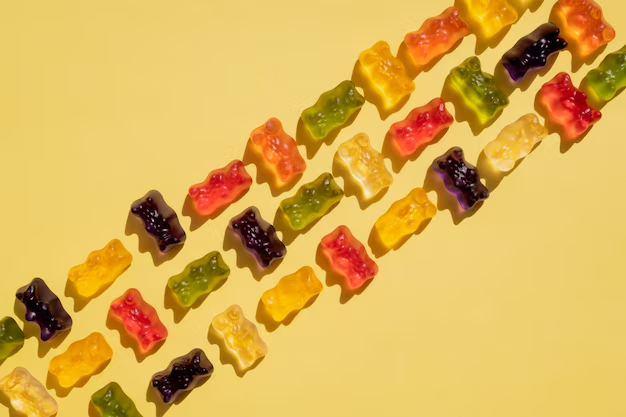
Context and Trends – The Evolution of Pectin and Gelatin in Candy
Gelatin’s Historical Dominance in Candy
Gelatin has long ruled the candy world, and its rise is tied to the 20th century’s industrial boom. Made from animal collagen—cheap and abundant as a byproduct—it powered the gummy revolution, from Jell-O’s wobbly desserts to the iconic gummy bear, born in Germany in the 1920s. Its advantages were clear:
- Versatility: Sets into chewy, elastic forms with minimal fuss.
- Scalability: Easy to produce in bulk, fueling mass-market candies.
By mid-century, gelatin was synonymous with fun, kid-friendly treats, cementing its place in confectionery history. Producers today still lean on its legacy for nostalgic, chewy classics that dominate shelves.
Pectin’s Modern Surge: Plant-Based Popularity
Pectin’s story is newer, gaining traction as diets shifted in the 21st century. Extracted from fruit peels, it’s been around since jams and jellies, but its candy role surged with veganism and health trends. Unlike gelatin, pectin offers a plant-based alternative, setting into firm, fruit-forward gels without animal inputs. Its rise reflects:
- Dietary Shift: Appeals to vegan and health-conscious consumers.
- Flavor Focus: Enhances fruit candies, a growing niche.
Producers now use pectin to tap into modern markets, crafting jellies and chews that align with clean-label demands, challenging gelatin’s once-unshakable grip.
Global Preferences: Pectin Jellies vs. Gelatin Gummies
Candy preferences vary worldwide, shaping how pectin and gelatin play out. In Europe, pectin rules fruit jellies—think French pâte de fruit or British jelly sweets—where firm, fruity bites match refined tastes. The U.S., meanwhile, loves gelatin gummies, from bears to worms, driven by a culture of playful, chewy snacks. To navigate these markets:
- Research Your Region: Europe leans pectin; North America favors gelatin.
- Test Local Flavors: Pair pectin with citrus in Europe, gelatin with mixed berries in the U.S.
- Adapt Texture: Firm up pectin for jellies, soften gelatin for gummies.
For global producers or exporters, understanding these cultural quirks helps tailor pectin or gelatin candies to regional palates.
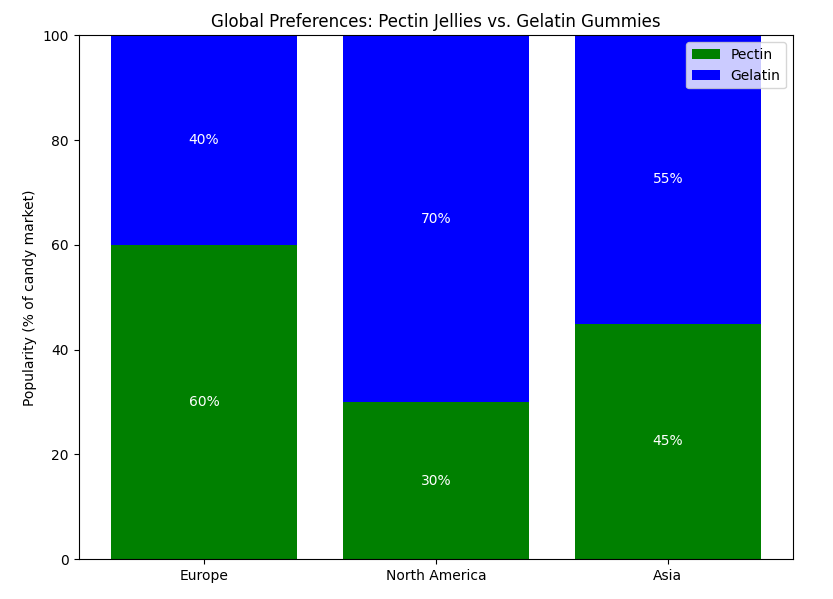
Future Directions: What’s Next for Candy Gels?
The future of pectin and gelatin in candy is evolving, with innovation on the horizon. Hybrid gels—blending pectin’s snap with gelatin’s chew—could merge the best of both worlds. Alternative proteins (e.g., fish gelatin) or plant gels (e.g., agar) might challenge tradition, while functional candies push boundaries. Trends to watch include:
- Sustainability: Plant-based gels like pectin gain eco-cred.
- Health Focus: Gelatin leads in collagen or vitamin gummies.
Producers can stay ahead by experimenting with these shifts, ensuring their pectin or gelatin candies meet tomorrow’s demands, from niche health products to mass-market treats. For gelatin-based innovations, collaborating with an edible gelatin manufacturer like Funingpu can provide the quality and versatility needed to lead the charge.
Final Thoughts
Pectin vs. Gelatin shapes the heart of candy-making, each offering unique strengths—pectin’s firm, plant-based appeal or gelatin’s chewy, versatile charm. For gelatin, partnering with a trusted gelatin manufacturer like Funingpu ensures access to edible gelatin, ideal for consistent gummies. This guide equips producers with tools to choose wisely—whether crafting niche jellies or scalable treats with Funingpu gelatin—ensuring texture, flavor, and production align with market goals. Experiment, refine, and succeed with quality options from edible gelatin manufacturers.
Phone: +86-577-88105990
Mobile: +86-138 5886 1938
Official Website: www.fnp-gelatin.com
Email: sales@funingpu.com
Address: No. 1-10 Wenpu Road, Yacheng Town, Xiapu County, Ningde City, Fujian Province

